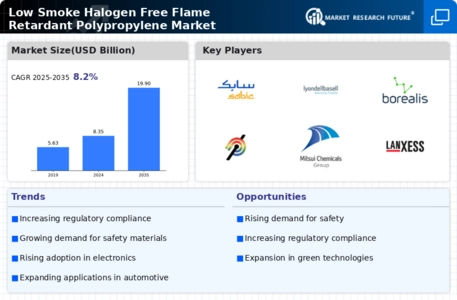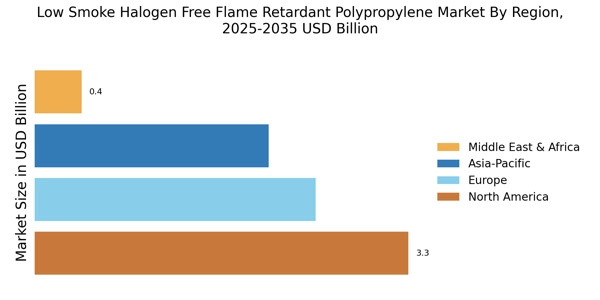Regulatory Compliance Pressure
The Low Smoke Halogen Free Flame Retardant Polypropylene Market is experiencing heightened pressure from regulatory bodies to comply with stringent safety standards. Governments are increasingly mandating the use of flame retardant materials in various applications, particularly in construction and automotive sectors. This regulatory landscape is driving manufacturers to adopt low smoke halogen free flame retardant polypropylene, which meets these safety requirements while minimizing environmental impact. As a result, the market is projected to grow at a compound annual growth rate of approximately 5% over the next five years, reflecting the increasing demand for compliant materials. Companies that proactively align their products with these regulations are likely to gain a competitive edge, further propelling the market forward.
Expansion of End-Use Applications
The Low Smoke Halogen Free Flame Retardant Polypropylene Market is witnessing an expansion in end-use applications, which is significantly contributing to its growth. Industries such as automotive, electronics, and construction are increasingly adopting low smoke halogen free flame retardant polypropylene due to its favorable properties, including lightweight, durability, and flame resistance. The automotive sector, for instance, is projected to account for a substantial share of the market, driven by the need for lightweight materials that enhance fuel efficiency while ensuring safety. Furthermore, the construction industry is also embracing these materials for insulation and wiring applications. This diversification of applications is likely to propel the market forward, as manufacturers seek to meet the evolving needs of various sectors.
Increased Awareness of Fire Safety
The Low Smoke Halogen Free Flame Retardant Polypropylene Market is benefiting from a growing awareness of fire safety among consumers and businesses. As incidents of fire-related accidents continue to garner media attention, there is a heightened focus on using materials that can mitigate fire risks. This awareness is driving demand for low smoke halogen free flame retardant polypropylene, which offers superior fire safety characteristics compared to traditional materials. Industries such as construction and transportation are particularly influenced by this trend, as stakeholders prioritize safety in their projects. The market is expected to see a steady increase in demand as more entities recognize the importance of incorporating fire-resistant materials into their designs.
Rising Demand for Sustainable Materials
In the context of the Low Smoke Halogen Free Flame Retardant Polypropylene Market, there is a notable shift towards sustainable materials. Consumers and manufacturers alike are becoming more environmentally conscious, leading to a growing preference for products that do not contain harmful halogens. This trend is particularly evident in sectors such as electronics and construction, where the demand for eco-friendly materials is surging. The market for low smoke halogen free flame retardant polypropylene is expected to expand as companies seek to enhance their sustainability profiles. Recent data indicates that the sustainable materials market is projected to reach USD 150 billion by 2026, suggesting a robust opportunity for low smoke halogen free flame retardant polypropylene to capture a significant share of this growing segment.
Technological Innovations in Production
Technological advancements are playing a crucial role in shaping the Low Smoke Halogen Free Flame Retardant Polypropylene Market. Innovations in production techniques are enabling manufacturers to create more efficient and effective flame retardant formulations. These advancements not only improve the performance of polypropylene but also reduce production costs, making it more accessible to a wider range of applications. For instance, the development of new additives and processing methods has enhanced the material's flame resistance while maintaining its mechanical properties. As a result, the market is likely to witness an increase in adoption across various industries, including automotive and construction, where safety and performance are paramount.


















Leave a Comment